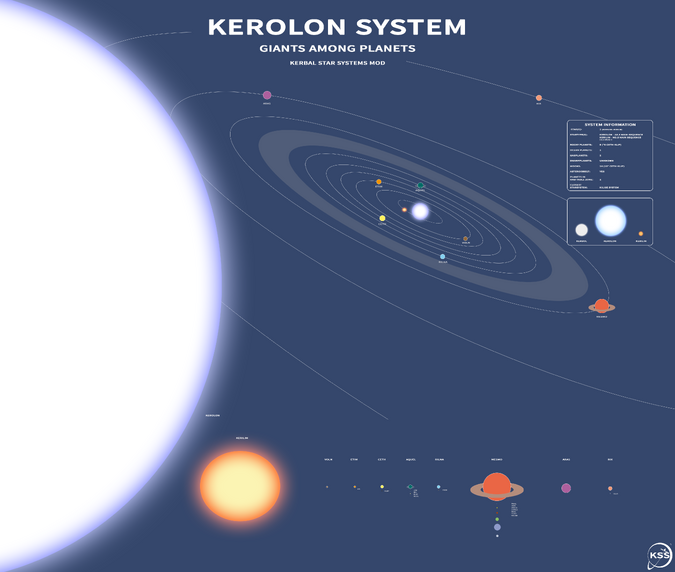The Kerolon System is a close binary between Kerolon (A-type main sequence) and Kerilim (K-type main sequence). The binary is surrounded by a system of 8 planets.
History
The Kerolon System's origin dates back to just over a billion years ago, when a cloud of interstellar gas composed of hydrogen, helium, and fine dust collapsed into a disk under its own gravity. The bulging center of this disk became Kerolon and Kirilim, and the fringes clumped into eight protoplanets. One of them grew rapidly into the monstrosity known as Mesmo today, which robbed surrounding disk materials and stunted the growth of Aras and Rix. Scientists reckon that the Kerolon disk initially had enough hydrogen to create a third star, but the gases were spread among Mesmo, Nisc, and Aras, preventing any one of them from reaching the critical mass required to begin fusion. Mesmo's mass was large enough for it to accumulate a large amount of dust and gas from the stellar disk around itself, allowing for the formation of planet sized moons. The orbits of the planets initially were packed closer together, while the distance between Kerolon and Kirilim was further apart. This allowed Etim to become a Cthonian planet by having its atmospheric gases stripped off by intense solar radiation. Over millions of years, the planets began to gravitationally "steal" orbital momentum from Kerolon and Kerilim, forcing the stars to move closer together and pushing the planetary orbits outward (In the future, Kerolon and Kerilim could collide. This could result in a spectacular explosion or a slight lengthening of Kerolon's lifespan. Kerbal scientists believe the former is more likely). Kerolon also became rapidly brighter over the course of its life, which shifted the habitable zone considerably from where it was at first. Eventually these forces shaped the Kerolon System into what we see today.
Properties
Being a close binary system, Kerolon and Kerilim's planets orbit far out compared to the orbital radii of the stars themselves. Over thousands of years, Kerilim's gentle gravitational tugs cause planetary orbits to undergo precession. Currently, only 2 planets has managed to remain between Kerolon/Kerilim and the habitable zone.
Because Kerolon and Kerilim are eclipsing binaries, one occasionally appears to block the other from the viewpoint of a planetary surface. This causes a momentary drop in brightness that can be noticeable to close-in planets.
From far away worlds, Kerolon may appear to be a regularly fluctuating variable star. This was what kerbal astronomers believed until the discovery of Kerilim centuries later, using advanced optical telescopes.
Kerolon and Kerilim
Kerolon and Kerilim are in what is known as a close binary, a binary star system with the stars being close to each other. None of the planets orbit within the binary.
Due to Kerolon and Kerilim being so close to each other, Kerilim has little effect on the habitable zone and the orbits of the planets in the system.
List of Bodies
Kerolon/Kerilim
Habitable Worlds
The Kerolon System is currently home to three habitable worlds and six organic worlds. Two planets (Aquel, Rilna) are in the habitable zone.
- Ceth (Organic)
- Aquel (Subhabitable)
- Mer (Organic)
- Rilna (Subhabitable)
- Mesmo (Sterile, with habitable moons)
- Dolis (Organic)
- Ernes (Subhabitable)
- Nisc (Organic)
- Rix (Organic)
- Ilen (Organic)
Visual Diagram

Trivia
- All the planets in the Kerolon System exhibit P-type orbits, meaning the orbits revolve around both stars. A planet that only revolves around one star in a multiple star system is said to possess S-type orbits.
- The Kerolon System is the only system in KSS with an A-type (or blue) star.
- On any body in the Kerolon System, you'd see two shadows of yourself: one from Kerolon and one from Kerilim.
- Because of the tendency of A-type stars to brighten quickly compared to smaller star types, Aquel has only recently (geologically speaking) entered the habitable zone of Kerolon. The planet that spent the longest time in Kerolon's habitable zone is Ceth, and so most life in the Kerolon System likely spread out from there.
- Etim was likely once in the habitable zone of Kerolon, and so might have once been a gentle giant before it exited the zone and became a chthonian planet.
- Eventually the habitable zone will reach past Mesmo and maybe even reach Rix before Kerolon dies in less than 2 billion years.